“The evidence in this portrait of mobile consumers highlights the importance of mobile technologies to the future of B2B (Business to Business) and B2C (Business to Consumer) industries.”
This article explores the data behind the “Portrait of a Mobile Consumer” infographic that my company,Vouchercloud, produced recently. The evidence in this portrait of mobile consumers highlights the importance of mobile technologies to the future of B2B (Business to Business) and B2C (Business to Consumer) industries.
Mobile Usage Data
As Figure 1 shows, consumer use of mobile platforms is huge and expected to rise to 8.2 billion users by 2018. A great variety of tablets and smartphones is now available on the market. In 2013 alone, sales of new mobile devices exceeded half a billion devices. Users are now becoming adept at using multiple computing platforms at the same time. In fact, 63% of mobile device users confess to using phones and tablets as secondary devices while also browsing using other computing hardware. Indeed, news of a strategic partnership between Apple and IBM demonstrates the importance of mobile to B2B companies and multiple-platform users alike.
Figure 1—Mobile usage data
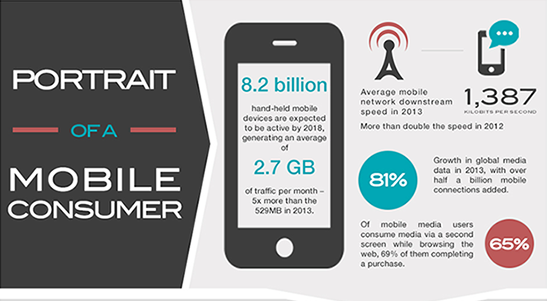
The Cloud and Mobile Data
The cloud is set to continue as the major source of data for mobile users, with information coming from the cloud increasing to 90% in 2018, compared to 82% in 2013. The increased availability of 4G networks will enhance the user experience, by improving speeds and download capabilities. With increases in both network capacity and the number of people using multiple mobile devices, experts expect that network operators will likely start offering mobile broadband packages as fixed-price deals. Figure 2 depicts this data.
Mobile Commerce
The sustained growth in mobile usage will have a significant impact on businesses that are considering selling online. The increasing importance of easy-to-use, responsive, online sales platforms is clear. Astonishingly, m-commerce is expected to reach $626 billion in sales by 2018, compared to $636 billion across all platforms now, as shown in Figure 2. This will come as no surprise in the Far East. In Japan, for example, 30% of all ecommerce sales are now via mobile platforms. In Q4 of 2013, 50% of all Amazon sales came from mobile sources. Plus, online payments provider PayPal saw a 115% growth in mobile transactions on Black Friday. You can see more information about mobile commerce in Figure 2.
Figure 2—More data from the cloud over faster connections and growth in mobile commerce
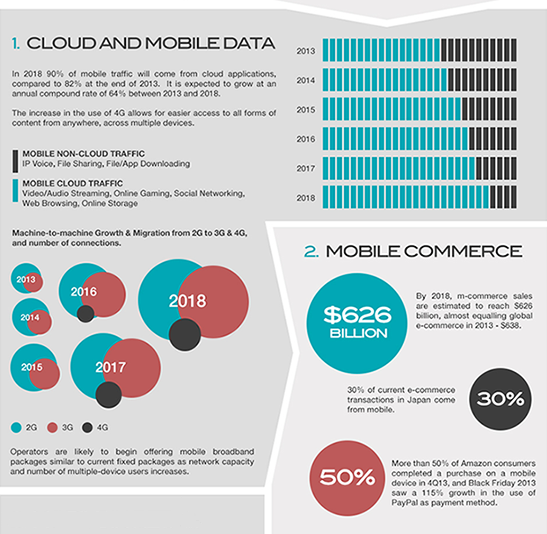
Mobile in Retail
One significant growth area in the usage of mobile technologies takes the form of enhancements that mobile can provide to the real-world shopping experience. Although there is still a long way to go, over 90% of mobile users regularly use devices to check information such as store opening times and locations. Over the last few years, brands have gone all out in facilitating the use of mobile wallets and payments and offering value-added services.
In the future, we’ll see companies enhance the full in-store shopping experience. Interesting developments are already occurring to improve things like parking, transport, access, and evening or night-time shopping for users. Brands are also investing heavily in research on how the use of mobile may affect consumer behavior through loyalty schemes and discount vouchers. Expect the all-around in-store shopping experience to change as apps and augmented reality bring the shopping experience to life.
There are still more developments afoot in the retail arena, particularly in making payments and product selection more efficient. We’ll see further integration of Near Field Communications (NFR) and QR Codes (Quick Response Codes). The widespread availability of apps employing these technologies will improve the interactive in-store experience, increase payment efficiency, and deliver evolutions in the use of vouchers and loyalty schemes. Indeed, installations of NFR-ready, point-of-sale terminals are expected to grow from around 7 million now to almost 45 million in 2017. Figure 3 depicts the evolution of mobile in retail contexts.
Figure 3—Mobile in retail
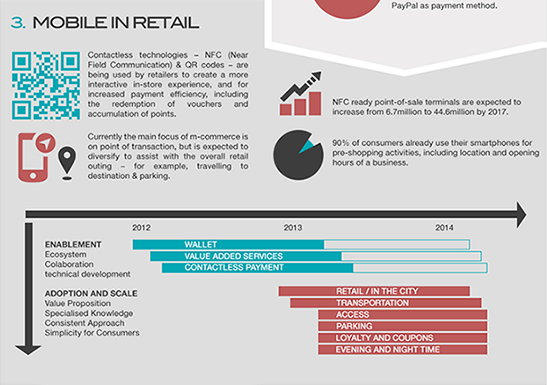
Mobile Visuals
Changes in network speeds, data storage, and connectivity will also likely impact the media that we have traditionally used to connect with each other. Continued increases in the consumption of mobile video will counterbalance the decreases in the use of text and pictures. It is expected that video will make up 69% of all mobile traffic by 2018, as shown in Figure 4.
Figure 4—Consumption of media via mobile
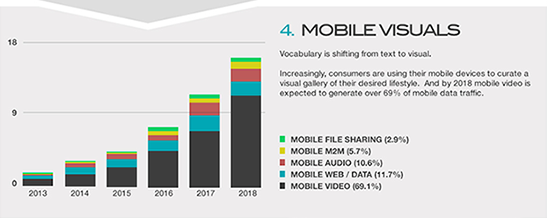
Businesses and Mobile Consumers
As Figure 5 shows, the focus of businesses’ relationships with mobile consumers is on personalization, localization, and building trust. As analytics improve, social media will continue to be at the forefront of interpersonal connections between businesses and consumers. Brands will continue to analyze trends in our buying habits, vying to be the product of choice.
The ever-improving analytics of social networks have led to the growth in ambient commerce—whereby the seller can anticipate the needs of mobile consumers and automatically provide purchasing opportunities without any prompting from users. Social networks continue to be a driver in influencing sales as well, with consumers making 92% of purchases following a recommendation from someone they trust on a social networking site. Plus, 70% of purchasers are likely to trust opinions that consumers have posted online. The fact that Facebook currently has over 1.2 billion active users and over 700 million postings on a daily basis further underscores the importance of social.
Increases in the numbers of net-savvy shoppers have far-reaching implications for the growth of mobile commerce. More and more often, shoppers are using mobile devices, not only to shop, but to compare deals. For retailers, this means getting ahead of the game and knowing what else is on the market. The rise in group-purchasing and price-comparison sites, coupled with shoppers’ ability to compare prices anywhere they can get a connection means brands must offer deals that are in line with the market.
Figure 5—Businesses and mobile consumers
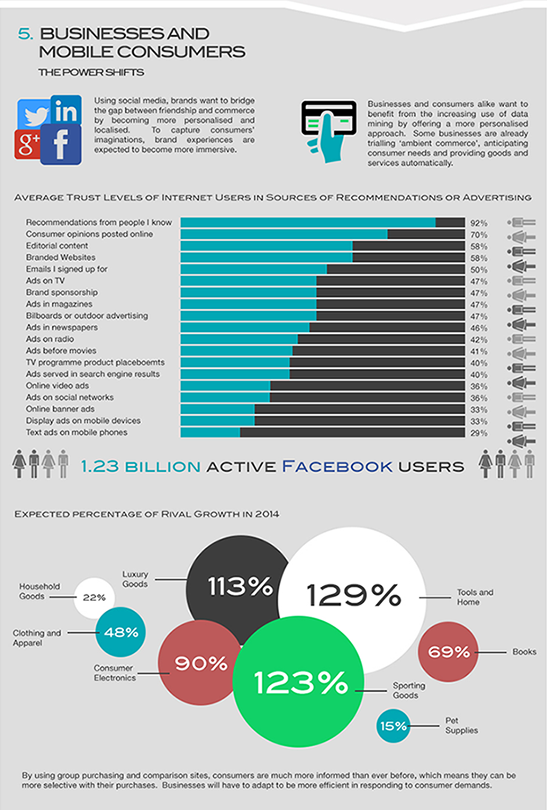
Lifestyle and Environment
Figure 6 depicts trends in lifestyles and the environments in which mobile consumers live. For example, as Millennials have become more and more disillusioned by the prevalence of sweat shops, corrupt financial services, and tax havens, the ethical standpoint of the consumer has changed. In fact, global warming and climate change were the third most common English phrases that appeared online in 2013. Consumers are becoming far more ethically minded, and this is reflected in the growth of brands such as Tom’s Footwear and Innocent Smoothies.
Figure 6—Trends in lifestyles and mobile consumers’ environments
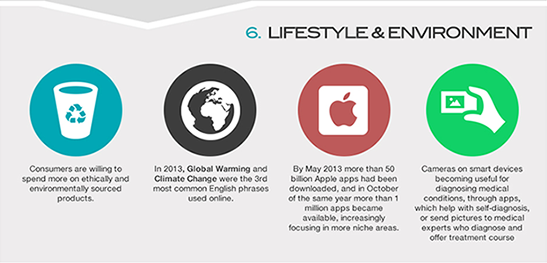
Ever-developing uses of technology continually affect the evolution of mobile commerce. The impacts of the growth and variety of mobile apps have been significant. For example, the latest taxi-sharing app, Uber, has caused controversy inside and outside the industry. In 2013, consumers downloaded 50 billion iPhone and iPad apps from the Apple App Store, and there were over 1 million apps available on the market.
Finally, people are also finding new, innovative uses for mobile technology. For example, there has been growth in the number of patients who are using camera phones to take pictures of bumps and rashes, then sending them to doctors for diagnosis via their mobile phones.
Conclusion
It is evident that advances in mobile technology and their uptake by consumers will continue at a fast pace. As we move further into the 21st century, the companies who keep up with these changes are sure to steal a march on the competition. Keeping the changing environment in mind, how mobile-ready is your business?
View the Complete Infographic
To see the entire, full-sized “Portrait of a Mobile Consumer” infographic, click this link.



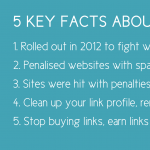
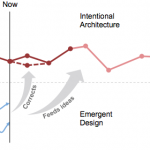



No Comments on this Post.Be the first